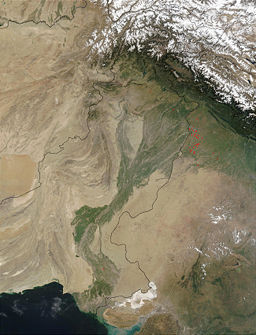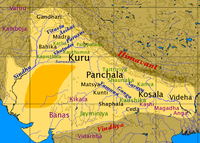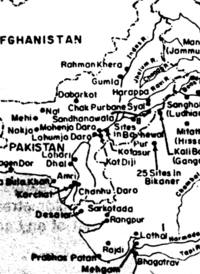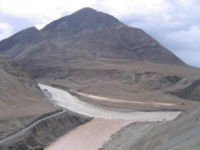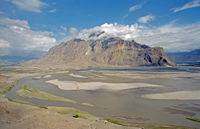Indus River
2008/9 Schools Wikipedia Selection. Related subjects: Geography of Asia
| Indus | |
|---|---|
| Sindh, Sindhu, Hindu, Abasin, Sengge Chu, Yìndù | |
|
Satellite image of the Indus River basin.
|
|
| Country | Pakistan |
| States | Punjab, Jammu and Kashmir, Sindh |
| Length | 3,200 km (2,000 mi) approx. |
| Watershed | 1,165,000 km² (450,000 sq mi) approx. |
| Discharge at | Arabian Sea |
| - average | 6,600 m³/ s (230,000 cu ft/ s) approx. |
| Source | Confluence of the Sengge and Gar rivers |
| - location | Tibetan Plateau, Tibet, China |
| Mouth | Sapta Sindhu |
| - location | Sindh, Pakistan |
| - elevation | 0 m (0 ft) |
The Indus River {Hindi and Sanskrit: सिन्धु Sindhu; Urdu: سندھ Sindh; Sindhi: سندھو Sindhu; Punjabi (Shahmukhi: سندھ, Gurmukhi: ਸਿੰਧੂ) Sindhu; Persian: Hinduحندو ; Pashto: Abasin ّآباسن"Father of Rivers"; Tibetan: Sengge Chu "Lion River"; Chinese: 印度 Yìndù; Greek: Ινδός Indos} is the longest river and the third largest river, in terms of annual flow, in Pakistan and the subcontinent. It is often considered the life-line of Pakistan. The Europeans used the name "India" for the entire subcontinent based on the appellation of this river. Originating in the Tibetan plateau in the vicinity of Lake Mansarovar, the river runs a course through Ladakh district of Jammu and Kashmir and Northern Areas, flowing through the North in a southerly direction along the entire length of the country, to merge into the Arabian Sea near Pakistan's port city Karachi. The total length of the river is 3,180 kilometres (1,976 miles). The river has a total drainage area exceeding 1,165,000 square kilometres (450,000 square miles). The river's estimated annual flow stands at around 207 cubic kilometres. Beginning at the heights of the world with glaciers, the river feeds the ecosystem of temperate forests, plains and arid countryside. Together with the rivers Chenab, Ravi, Sutlej, Jhelum, Beas and the extinct Sarasvati River, the Indus forms the Sapta Sindhu ("Seven Rivers") delta in the Sindh province of Pakistan. It has 20 major tributaries.
The Indus provides the key water resources for the economy of Pakistan - especially the breadbasket of Punjab province, which accounts for most of the nation's agricultural production, and Sindh. The word "Punjab" is a combination of the Persian words 'panj' (پنج) Five, and 'āb' (آب) Water, giving the literal meaning of the Land of the Five Rivers. The five rivers after which Punjab is named are the Beas, Jhelum, Chenab, Ravi and Sutlej. The river also supports many heavy industries and provides the main supply of potable water in Pakistan.
The ultimate source of the Indus is in Tibet; it begins at the confluence of the Sengge and Gar rivers that drain the Nganglong Kangri and Gangdise Shan mountain ranges. The Indus then flows northwest through Ladakh and Baltistan into Gilgit, just south of the Karakoram range. The Shyok, Shigar and Gilgit streams carry glacial waters into the main river. It gradually bends to the south, coming out of the hills between Peshawar and Rawalpindi. The Indus passes gigantic gorges 4,500-5,200 metres (15,000-17,000 feet) high near the Nanga Parbat massif. It flows swiftly across Hazara, and is dammed at the Tarbela Reservoir. The Kabul River joins it near Attock. The remainder of its route to the sea is in plains of the Punjab and Sindh, and the river becomes slow-flowing and highly braided. It is joined by Panjnad River at Mithankot. Beyond this confluence, the river, at one time, was named Satnad River (sat = seven, nadi = river), as the river was now carrying the waters of Kabul River, Indus River and the five Punjab rivers. Passing by Jamshoro, it ends in a large delta to the east of Thatta.
The Indus is one of the few rivers in the world that exhibit a tidal bore. The Indus system is largely fed by the snows and glaciers of the Karakoram, Hindu Kush and Himalayan ranges of Tibet, Kashmir and Northern Areas of Pakistan. The flow of the river is also determined by the seasons - it diminishes greatly in the winter, while flooding its banks in the monsoon months from July to September. There is also evidence of a steady shift in the course of the river since prehistoric times - it deviated westwards from flowing into the Rann of Kutch.
History
Paleolithic sites have been discovered in Pothohar near Pakistan' s capital Islamabad, with the stone tools of the Soan Culture. In ancient Gandhara (Near the Pakistani capital of Islamabad), evidence of cave dwellers dated 15,000 years ago has been discovered at Mardan.
The major cities of the Indus Valley Civilization, such as Harappa and Mohenjo-daro, date back to around 3300 BC, and represent some of the largest human habitations of the ancient world. The Indus Valley Civilization extended from Balochistan to Gujarat, with an upward reach from east of Jhelum River to Ropar on the upper Sutlej. The coastal settlements extended from Sutkagan Dor at the Iranian border to Lothal in Gujarat. There is an Indus site on the Oxus river at Shortughai in northern Afghanistan (Kenoyer 1998:96), and the Indus site Alamgirpur at the Hindon River is located only 28 km from Delhi (S.P. Gupta 1995:183). To date, over 1,052 cities and settlements have been found, mainly in the general region of the Ghaggar-Hakra River and its tributaries. Among the settlements were the major urban centers of Harappa and Mohenjo-daro, as well as Lothal, Dholavira, Ganeriwala, and Rakhigarhi. Only 90-96 of the over-800 known Indus Valley sites have been discovered on the Indus and its tributaries. The Sutlej, now a tributary of the Indus, in Harappan times flowed into the Ghaggar-Hakra River, in the watershed of which were more Harappan sites than along the Indus (S.P. Gupta 1995: 183).
Most scholars believe that settlements of Gandhara grave culture of the early Indo-Aryans flourished in Gandhara from 1700 BC to 600 BC, when Mohenjo-daro and Harappa had already been abandoned.
The name Indus is a Latinization of Hindu, in turn the Iranian variant of Sindhu, the name of the Indus in the Rigveda. Sanskrit Sindhu generically means "river, stream, ocean", probably from a root sidh "to keep off"; sindhu is attested 176 times in the Rigveda, 95 times in the plural, more often used in the generic meaning. Already in the Rigveda, notably in the later hymns, the meaning of the word is narrowed to refer to the Indus river in particular, for example in the list of rivers of the Nadistuti sukta. This resulted in the anomaly of a river with masculine gender: all other Rigvedic rivers are female, not just grammatically, being imagined as goddesses and compared to cows and mares yielding milk and butter.
The Indus has formed a natural boundary between the Indian Subcontinent hinterland and its frontier with Afghanistan and Iran. It has been crossed by the armies of Alexander the Great - His Macedonian forces retreated along the southern course of the river at the end of the Asian campaign after conquering Pakistan and joining it to the Hellenic Empire. The Indus plains have also been under the domination of the Persian empire and the Kushan empire. The Muslim armies of Muhammad bin Qasim, Mahmud of Ghazni and Babur also crossed the river to strike into the inner regions of Gujarat, Punjab and Rajasthan. It is due to this diverse history that gave the modern day country of Pakistan its uniqueness and clearly distinguishes it from the rest of South Asia and Asia for that matter.
The word "India" is a reference to the Indus River. In ancient times, India referred to the region of modern day Pakistan along the Indus river which traded extensively with the ancient world. It was only after the arrival of the British in the 16th century that name began to be applied to the entire region. Incidentally, Pakistan's founding father, Mohammed Ali Jinnah was quite surprised to learn that upon the departure of Britain from the region, that its new neighbour to the east was going to retain the name India as the country's official name..
Geography
Tributaries
|
|
|
Geology
The Indus River feeds the Indus submarine fan located in the Arabian Sea, which is the second largest sediment body on the Earth at around 5 million cubic kilometres of material eroded from the mountains. Studies of the sediment in the modern river indicate that the Karakoram Mountains in northern Pakistan are the single most important source of material, with the Himalayas providing the next largest contribution, mostly via the large rivers of the Punjab (i.e., the Jhelum, Ravi, Chenab, Beas and the Sutlej). Analysis of sediments from the Arabian Sea by marine geologists Peter Clift and Jerzy Blusztajn has demonstrated that prior to five million years ago the Indus was not connected to these Punjab rivers which instead flowed east into the Ganges and were captured after that time. Earlier work, also by Peter Clift, showed that sand and silt from western Tibet was reaching the Arabian Sea by 45 million years ago, implying the existence of an ancient Indus River by that time. The delta of this proto-Indus river has subsequently been found in the Katawaz Basin, on the Afghan-Pakistan border. Most recently the Indus was paralleled by the ancient Saraswati River, which the Rigveda suggests flowed from the Himalayas between the Sutlej and the Yamuna Rivers, close to modern day Chandigarh. Reportedly the Saraswati River was totally dried by 1900 BC as confirmed by archaeological hydrological radiocarbon dating.
Wildlife
Accounts of the Indus valley from the times of Alexander's campaign indicate a healthy forest cover in the region, which has now considerably receded. The Mughal Emperor Babar writes of encountering rhinoceroses along its bank in his memoirs (the Baburnama). Extensive deforestation and human interference in the ecology of the Shivalik Hills has led to a marked deterioration in vegetation and growing conditions. The Indus valley regions are arid with poor vegetation. Agriculture is sustained largely due to irrigation works.
The Blind Indus River Dolphin (Platanista gangetica minor) is a sub-species of Dolphins found only in the Indus River. It formerly also occurred in the tributaries of the Indus river. Palla fish ( Hilsa ilisha) of the river is a delicacy for people living along the river. The population of fishes in the river is moderately high, with Sukkur, Thatta and Kotri being the major fishing centres - all in the lower Sindh course. But damming and irrigation has made fish farming an important economic activity. Located southeast of Karachi, the large delta has been recognised by conservationists as one of the world's most important ecological regions. Here the river turns into many marshes, streams and creeks and meets the sea at shallow levels. Here marine fishes are found in abundance, including Pomfret and Prawns.
Economy
The Indus is the most important supplier of water resources to the Punjab and Sindh plains - it forms the backbone of agriculture and food production in Pakistan. The river is especially critical as rainfall is meagre in the lower Indus valley. Irrigation canals were first built by the people of the Indus valley civilization, and later by the engineers of the Kushan Empire and the Mughal Empire. Modern irrigation was introduced by the British East India Company in 1850 - the construction of modern canals accompanied with the restoration of old canals. The British supervised the construction of one of the most complex irrigation networks in the world. The Guddu Barrage is 1,350 metres (4,450 ft) long - irrigating Sukkur, Jacobabad, Larkana and Kalat. The Sukkur Barrage serves over 20,000 square kilometres (5,000,000 acres).
After the partition, a water control treaty signed between India and Pakistan in 1960 guaranteed that Pakistan would receive water from the Indus River independent of upstream control by India. The project, Indus Basin Project, consisted primarily of the construction of two main dams, the Mangla Dam built on the Jhelum River and the Tarbela Dam constructed on the Indus River, together with their subsidiary dams. The Pakistan Water and Power Development Authority undertook the construction of the Chashma-Jhelum link canal - linking the waters of the Indus and Jhelum rivers - extending water supplies to the regions of Bahawalpur and Multan. Pakistan constructed the Tarbela Dam near Rawalpindi - standing 2743 metres (9,000 ft) long and 143 metres (470 ft) high, with an 80 kilometre (50 mile) long reservoir. The Kotri Barrage near Hyderabad is 915 metres (3,000 ft) long and provides additional supplies for Karachi. The Taunsa Barrage near Dera Ghazi Khan produces 100,000 kilowatts of electricity. The extensive linking of tributaries with the Indus has helped spread water resources to the valley of Peshawar, the Northwest Frontier Province. The extensive irrigation and dam projects provide the basis for Pakistan's large production of crops such as cotton, sugarcane and wheat. The dams also generate electricity for heavy industries and urban centres.
People
The inhabitants of the regions through whom the Indus river passes and forms a major natural feature and resource are diverse in ethnicity, religion, national and linguistic backgrounds. On the northern course of the river in Jammu and Kashmir live the Buddhist people of Ladakh, of Tibetan stock, with Kashmiris who practice both Islam and Hinduism. As it descends into Northern Areas of Pakistan, the Indus river forms a distinctive boundary of ethnicity and cultures - upon the western banks the population is largely Pashtun, Baloch, and of other Iranian stock, with close cultural, economic and ethnic ties to Iran and Afghanistan. The eastern banks are largely populated by peoples of Indo-Aryan stock, such as the Punjabis, the Sindhis and the Seraikis. In northern Punjab and the North-West Frontier Province, ethnic Pashtun tribes live alongside Punjabi peoples. In the southern portion of the Punjab province, the Saraiki peoples speak a distinctive tongue and practise distinctive traditions. In the province of Sindh, peoples of Sindhi and Punjabi backgrounds form the local populations. Upon the western banks of the river live the Balochi and Pashtun peoples of Balochistan.
Modern issues
The Indus is a strategically vital resource for Pakistan's economy and society. After the partition of British India in 1947, the use of the waters of the Indus and its five eastern tributaries became a major dispute between India and Pakistan. The irrigation canals of the Sutlej valley and the Bari Doab were split - with the canals lying primarily in Pakistan and the headwork dams in India - disrupting supply in some parts of Pakistan. The concern over India building large dams over various Punjab rivers that could undercut the supply flowing to Pakistan, as well as the possibility that India could divert rivers in the time of war, caused political consternation in Pakistan. Holding diplomatic talks brokered by the World Bank, India and Pakistan signed the Indus Waters Treaty in 1960. The treaty gave India control of the three easternmost rivers of the Punjab, Sutlej, Beas and the Ravi, while Pakistan gained control of the three western rivers, Jhelum, Chenab and the Indus. India retained the right to use of the western rivers for non irrigation projects. (See discussion regarding a recent dispute about a hydroelectric project on the Chenab (not Indus) known as the Baghlighar project).
Hindu pilgrimage to holy sites alongside the river has been a source of conflict between the two nations. Pakistan does generally allow Indian citizens to visit the country for religious purposes, However, owing to the volatile nature of bilateral relations, most pilgrimage and religious ceremonies are performed by Hindus in Indian administered Jammu and Kashmir.
There are concerns that extensive deforestation, industrial pollution and global warming are affecting the vegetation and wildlife of the Indus delta, while affecting agricultural production as well. There are also concerns that the Indus river may be shifting its course westwards - although the progression spans centuries. On numerous occasions, sediment clogging owing to poor maintenance of canals has affected agricultural production and vegetation. In addition, extreme heat has caused water to evaporate, leaving salt deposits that render lands useless for cultivation.
